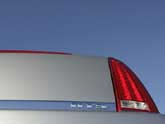Recent Articles
Popular Makes
Body Types
2006 Cadillac DTS First Drive
Yesterday's Cadillac takes a final, graceful bow
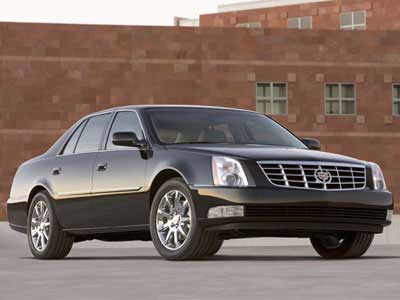
SANTA MONICA, Calif. – Cadillac must serve two distinctly different masters as it transforms itself from the ersatz-luxury division of its corporate parent, General Motors, into a globally viable and respected purveyor of premium automobiles. At one end of the spectrum, youthful, affluent, influential buyers can break a product if it doesn’t exude status and authenticity. At the other end of the spectrum, fiercely loyal customers who fought world wars and can remember first-hand when the wreath-and-crest hood ornament symbolized the standard of the world just want a big, cushy, made-in-America luxo-cruiser that glides from Michigan or Minnesota to warmer climates each winter with a minimum of fuss and hassle. The 2006 Cadillac DTS, which replaces the venerable DeVille in the lineup, is the car charged with pleasing both camps. On Cadillac’s side to ensure future success is the entertainment industry, which embraced the Escalade SUV the moment it debuted, providing the company with implied celebrity endorsement through song lyrics and music videos, landing the brand smack in the middle of pop culture. Now, Cadillac is on the radar of today’s youth, partly because it’s been in the MTV spotlight, partly because modern creased-and-folded Cadillacs look like nothing else on the road, and partly because kids always want the opposite of what their parents do – and parents today don’t drive Cadillacs because parents did. And that makes Caddys cool, or phat, or sick, or whatever slang the under-25 crowd is using this week to assign acceptance and desirability. But the so-called traditional customer is still alive and kicking, toting golf clubs, filling parking slots at IHOP restaurants throughout the Sunbelt, and driving cross-country with the blinker on and racks of clothing strung across the rear seat. This contingent still thinks that “sick” means that someone doesn’t feel good. Cadillac needs a car to satisfy this customer, too, lest they defect to Lincoln or Chrysler. That’s why the 2006 Cadillac DTS exists, shepherding the DeVille into the automaker’s alphanumeric lineup and signifying that the “old” Cadillac is taking its final, rattling gasps of air. The new DTS creates a bridge between two diverse sets of customers, adopting the “art and science” design theme of modern Cadillacs while offering loyalists the sort of disconnected ride and handling they’ve come to know and love. The DTS is the last front-wheel drive model in Cadillac’s lineup, the only six-passenger sedan that Cadillac sells, and the final Cadillac to be aimed at recipients of Social Security benefits. Which makes the forward-thinking iPod jack on the dashboard rather ironic.
Model Mix
Model Mix Choose the 2006 Cadillac DTS Luxury if you want a traditional soft-riding and mushy-handling sedan. The more responsive and better-controlled DTS Performance is aimed at people who might otherwise select an import brand. The 2006 Cadillac DTS isn’t a new car. Rather, it’s a re-worked version of the existing DeVille. That means it’s still a large, front-wheel-drive sedan powered by a 4.6-liter Northstar V8 engine and a four-speed automatic transmission. Sold in a single trim level with multiple Luxury packages or a single Performance package, the DTS splits its personality along similar lines. In Luxury trim, it’s a traditional soft-riding, nose-heavy, mushy-handling sedan that’s quick off the line but possesses nary a dynamic handling trait. This is the DTS for the older crowd. In Performance trim, which includes a re-tuned engine, a different suspension, bigger wheels with more aggressive tires, and lots of standard equipment, the DTS is transformed into a responsive, controlled, almost fun luxury cruiser. This is the DTS for the younger crowd. Selected standard equipment on the DTS Luxury 1 model includes fake wood interior trim, eight-way power front seats covered in Nuance leather upholstery, triple-zone automatic climate control with air filtration, and an eight-speaker stereo with a CD player. The DTS Luxury 1 also includes remote engine starting, four-wheel-disc antilock brakes, traction control, 17-inch wheels and tires with a tire pressure monitor, and automatic rear suspension leveling. OnStar telematics with one year of free Virtual Advisor service is included, along with xenon high intensity discharge headlights that automatically illuminate when the windshield wipers are turned on, and heated sideview mirrors that improve visibility even further. The DTS Luxury 1 is the version most likely to land in Avis and National rental fleets as the top choice for moneyed travelers. Step up one rung to the DTS Luxury 2 if you live in a cold climate where snow covers the roads, and add a heated steering wheel, heated windshield washer system, heated and cooled front seats, heated rear seats, brake assist technology that helps in a panic stop, and StabiliTrak stability control. The DTS Luxury 2 also includes a memory package that recalls vehicle settings for two different drivers, XM satellite radio with three months of free service, and Ultrasonic front and rear parking assist. The DTS Luxury 3 piles on real burled walnut dashboard trim, a wood-trimmed power tilt and telescopic steering wheel with memory, and a Bose premium audio with Centerpoint signal processing and a six-disc in-dash CD changer. Chrome multi-spoke alloy wheels decorate the exterior, while front seat occupants can and thanks to a lumbar massage feature. The DTS Luxury 3 also gets a net and mat for the trunk, IntelliBeam automatic high-beam headlights, and rain-sensing windshield wipers. Versions equipped with the Performance package come with 18-inch wheels, lower-profile tires for better handling, a performance-tuned magnetic ride control suspension, and Performance Algorithm Shift software to make the transmission more responsive. Adaptive cruise control, a DVD navigation system with touch-screen control, a power sunroof, a power rear sunshade, and upgraded leather are optional on select DTS models. Safety gear includes a dual-stage driver airbag, a dual-depth front passenger airbag, side-impact airbags for the front seat occupants, and side-curtain airbags for all outboard seating positions. The dual-depth airbag design takes occupant seatbelt usage, seating position, and crash severity into account to deploy the front passenger airbag at a shallow depth or a deeper depth to protect the passenger. In the event of an accident that causes the airbags to deploy, the standard OnStar telematics system can notify rescue personnel of your location and status to speed medical treatment, if necessary. Cadillac also tosses in a free 12-month subscription to OnStar Virtual Advisor, which can provide weather and traffic updates, stock reports, and other vital data to consumers who select the 2006 Cadillac DTS. And to keep from becoming stranded with a flat tire, a tire pressure monitoring system is standard.
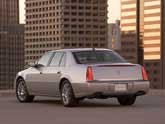
Nuts and Bolts
Nuts and Bolts Every 2006 Cadillac DTS is equipped with larger antilock brakes with brake assist and traction control. StabiliTrak stability control is standard on all but the base-level DTS, and when equipped with the Performance package a magnetic ride control suspension is included. Mainly because they’re sitting in the parts bin so GM might as well use them, two versions of the 4.6-liter Northstar V8 are available in the 2006 Cadillac DTS. The standard motor makes 275 horsepower and employs an electronic throttle control that is calibrated for the quick off-the-line and part-throttle response that Cadillac believes the traditional customer likes, while the optional version that’s included in the Performance package generates 291 horsepower at higher revs but whips up less peak torque, resulting in better mid-range response for highway passing. Both engines are mounted to a new front engine cradle, which itself is attached to the front frame rails for greater strength and a reduction in vibration. Cadillac says this revised engine mounting setup results in a quieter, smoother, more refined ride quality. Not surprisingly given the identical displacement and negligible differences in power ratings, the EPA gives each engine a fuel economy rating of 18 mpg in the city and 27 mpg on the highway. Between both motors, we managed an average of 18.8 mpg in a mix of city, highway, and country driving. Cadillac recommends the use of premium fuel for optimum performance, but doesn’t require it. Every 2006 Cadillac DTS is equipped with larger antilock brakes and traction control. StabiliTrak stability control and brake assist technology come standard on the Luxury 2, Luxury 3 and Performance packages, and when equipped with the Performance package the DTS gets a magnetic ride control suspension. Luxury models have a revised suspension that aims to quell body roll in corners and float over larger swells and dips in the pavement. Cadillac also includes a load-leveling rear suspension on every DTS to ensure predictable, stable handling. Standard equipment includes 17-inch wheels and tires, with 18-inch rims and rubber a part of the Performance package. Magnasteer magnetic variable assist steering is standard, but has been recalibrated for more linear off-center response and less tug back to center in long, sweeping curves. Minor structural modifications help stiffen up the structure to give the DTS nominal improvements in ride, handling, refinement, and safety.
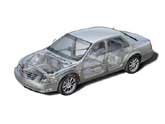
Design
Design Before setting foot inside the 2006 Cadillac DTS, company spokespeople claimed that the benchmark vehicle for interior quality was the Lexus LS 430. That set expectations very high, and in our opinion, Cadillac has not met its target. With the debut of the 2006 DTS, all Cadillac models feature the edgy styling that first debuted half a decade ago on the controversial Evoq concept car. Building on the old DeVille’s structure, from the windshield pillars forward, the 2006 Cadillac DTS is restyled with a new power-bulge hood, egg-crate grille, trapezoidal bi-xenon headlights, bumper fascia, and fenders. The doors and greenhouse are carried over from the current DeVille, but the alloy wheel designs are new. In back, the revised quarter panels, LED tail lamps, decklid, and bumper update the appearance of the DTS. The new look brings the DTS into line with the CTS and STS to create a familial resemblance, and the result is a handsome sedan that looks good going down the road. More important is the new interior design, which resolves the weaknesses of the old DeVille. Simpler and more elegant than before, the improvements to the 2006 Cadillac DTS’s cabin are instantly apparent to those familiar with the DeVille. The parts fit together better thanks to flush seams, the control layout is easier to use and understand than before, and the materials look and feel more upscale. However, before our test drive, company spokespeople claimed that the benchmark vehicle for interior quality was the Lexus LS 430. That set expectations very high, and in our opinion, Cadillac has not met its target. A Lexus LS 430 exudes luxury from every nook and cranny of its interior, the Cadillac not so much. Certainly, the DTS is a big improvement over the DeVille that it replaces, but this interior is more on par with the entry-luxury Lexus ES 330 than the ultra-luxury LS. Like many recent GM products, what looks good at first glance loses luster with closer inspection. From the excessive gaps between the driver airbag cover and the steering wheel spokes to the rough-edged plastic seam on the steering column, from the hollow thunk the center console lid makes when closing to the sagging black plastic bezel that surrounds the gauge cluster, it’s easy to find flaws inside the DTS. Surface treatments are either too obvious, like the graining on the soft-touch dash panels, or too plain, like the vinyl door inserts that would look better if they appeared to be gathered leather. Add in a dashboard that shows too much gloss in sunlight and gratuitous chrome surrounding an analog clock that throws blinding glare into the driver’s line of sight, and it’s apparent that GM’s designers need to spend more time outside of Michigan, where thick clouds shroud blue skies nine months out of the year. We’d also like to see greater attention to detail when it comes to control layout and placement. Lexus uses every inch of available real estate, creating large buttons and controls with clear markings that are easy to understand. In contrast, the 2006 Cadillac DTS is equipped with smaller buttons grouped closer together, some of which are marked by enigmatic symbols. For instance, we found the stereo’s deeper functions distracting to use, accessed through menus activated by the radio station pre-set buttons and displayed on a screen that was difficult to read in bright sunlight. On a positive note, every button, dial, and stalk operates with the sort of silken fluidity that has come to identify refinement. With the optional DVD navigation system, a touch-screen with voice-activated control manages stereo and navigation features. It seems simple enough, but during a demonstration by a Cadillac representative the voice commands didn’t respond consistently. With the DTS in Park, the navigation screen will play DVD movies with excellent sound coming through the optional Bose Centerpoint speakers. We also liked how the system made it easy to sort through your iPod files by song title, artist, and genre.
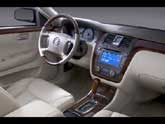
Comfort
Comfort In the pipeline for the future is a rear-seat DVD entertainment system, which nicely complements the spacious rear legroom on longer trips. Big luxury sedans are all about comfort, and the 2006 Cadillac DTS delivers with spacious, comfortable seating for up to six passengers. Completely redesigned for 2006, the power-adjustable front seats prove supportive for longer trips, though we suspect that larger people might wish that the bottom cushions were longer and wider. Our Luxury 2 test model did not come equipped with the power telescopic steering column that made the Performance version more pleasing, and Cadillac does not offer power adjustable pedals on the DTS. But the seatbelts are now located on the B-pillar, rather than integrated with the seat structure like before, making them easier to use and more comfortable for some people. And the cooled front seats work like a Frigidaire in Alaska. The rear bench is tall with a terrific view out and perfect thigh support. And with the triple-zone automatic climate control, rear seat passengers get to set their own temperature for optimum comfort. In the pipeline for the future is a rear-seat DVD entertainment system, which nicely complements the spacious rear legroom on longer trips. What’s missing is rear seat adjustment, like on some Infiniti sedans that sell for less. Though seating is comfortable, road trippers are likely to wish for larger storage areas. The door panel bins are small, the glovebox is shallow, and center console space is limited, providing few locations to stash the odds-and-ends we all carry with us on a daily basis. But the trunk is huge, with a low liftover height and concealed gooseneck hinges that won’t crush valuables.
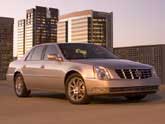
Driving Impressions
How it Drives The DTS Luxury delivers the ride and handling of a soft, heavy, front-wheel-drive car. In contrast, the difference in ride and handling is dramatic with the DTS Performance’s magnetic ride control suspension. Cadillac’s test route through the mountains and valleys of southern California included both Luxury and Performance package versions of the 2006 DTS. We selected the Luxury model for the first half of the day, and after hours of city and highway driving on freeways, two-lane roads, and side streets it was clear that the DTS Luxury delivers the ride and handling of a soft, heavy, front-wheel-drive car. In other words, a traditional luxo-barge. However, it should be noted that on Cadillac’s prescribed route, the DTS Luxury produced its cushiony ride without much wallow, a testament to the updated suspension tuning that supports the base model. The brakes and the steering also displayed linear application and response, making the DTS easy to guide and stop. In fact, the recalibrated Magnasteer system is excellent, no longer tugging back to center on sweeping curves and allowing for smooth transition from on-center to off-center inputs at the wheel. Competent P235/55R17 Continental Touring Contact tires do as much as possible to keep the DTS moving in the direction it’s pointed, but ultimately, the DTS Luxury’s handling limits are quite low, as Cadillac doesn’t expect this customer to charge hard through canyons. Not that the DTS Performance is a back-road barnstormer, either, despite the use of larger and lower profile P245/50R18 Bridgestone Turanza rubber. But the difference in ride and handling is dramatic with the DTS Performance’s magnetic ride control suspension. By using magnetically charged shock absorbers that electronically and continually react to input from four wheel-to-body displacement sensors, the DTS Performance can, at 60 mph, read suspension action for every inch of road traveled. Magnetic ride control responds not only to the road surface to keep the tires in full contact with the pavement but also to manage body roll and weight transfer to keep the car on an even plane and create smooth, well-controlled body motions at all times. With this suspension working its magic, any passenger in tune with the DTS’s handling and ride quality can immediately tell the difference between the Luxury and Performance models – you don’t need to get behind the wheel. The DTS Performance is an exceptionally composed, comfortable, and competent handler, most impressing us while driving down California’s storm-ravaged Pacific Coast Highway. Over one section of heaving pavement, the DTS remained level, stuck to the road, unfettered by the rumpled blacktop. Except for the price of the technology behind the suspension, there’s no reason the magnetic ride control underpinnings shouldn’t be made standard on all DTS models. Either V8 engine is pleasing, with the DTS Luxury’s lower horsepower but higher torque motor supplying a decent punch off the line and the DTS Performance’s higher-revving mill delivering impressive mid-range response for passing. Powering out of turns, however, we detected a slight driveline shudder common to front-drive, V8-powered Cadillacs. According to a company spokesman, this shudder is due to engine movement on the DTS’s cushy motor mounts and is nothing to be concerned about. What might concern DTS buyers is the engine grumble that gets into the cabin. This is fine, and desirable, on the Performance model, but is off-putting on Luxury versions. Another aural annoyance was wind noise at highway speeds, despite the DTS’s triple-sealed doors. Aesthetically, we preferred the tan leather and real walnut wood in our DTS Performance to the medium gray décor and fake wood of our DTS Luxury 2 test vehicle. The DTS Luxury seemed almost austere inside, while the DTS Performance made a better case for Cadillac’s assertion that designers benchmarked the Lexus LS 430 for interior materials and quality.
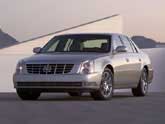
Wrap-up
Wrap-up Our pick is the 2006 Cadillac DTS Performance, a handsome, comfortable, and surprisingly responsive luxury cruiser well suited to daily commutes and cross-country drives. Weaning itself off the traditional buyer whose peculiar tastes almost killed the company, Cadillac gives its aging loyalist customer base one last shot at buying a brand-new canvas upon which it can slather fake cabriolet roofs, sparkling wire wheels, brassy gold packages, and Vogue tires. That last shot is the 2006 Cadillac DTS Luxury, complete with an optional stand-up hood ornament to completely bowl the middle-America AARP crowd over with glee. On the other hand, the 2006 Cadillac DTS Performance is an impressive update of a carryover car, closer to being competitive than any DeVille that has come before. It lacks the refinement and technology of a Lexus, the entertaining driving character of a BMW, and the brand cachet of either – unless you’re talking to the kid next door whose pants sag almost to his knees. But it’s loaded with Motor City attitude, and is a perfectly serviceable stopgap car to get Cadillac’s full-sized flagship from yesterday to tomorrow.
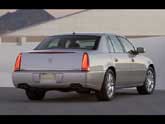
Specifications
Specifications The 2006 Cadillac DTS’s competitors include the Acura RL, Audi A6, BMW 5-Series, Chrysler 300, Infiniti M, Jaguar S-Type, Lexus GS, Lincoln Town Car, Mercedes-Benz E-Class, Saab 9-5, Volvo S80 Test Vehicle: 2006 Cadillac DTS Luxury; 2006 Cadillac DTS Performance Price Range: $42,000 to $52,000 (est.) Engine Size and Type: 4.6-liter V8 Engine Horsepower: 275 at 5,200 rpm (Luxury); 291 at 5,600 rpm (Performance) Engine Torque: 292 lb.-ft. at 4,400 rpm (Luxury); 286 lb.-ft. at 4,400 rpm (Performance) Transmission: Four-speed automatic Curb weight, lbs.: 4,009 (Luxury) EPA Fuel Economy (city/highway): 18/27 (Luxury); 18/27 (Performance) Observed Fuel Economy: 18.3 mpg Length: 207.6 inches Width: 74.8 inches Wheelbase: 115.6 inches Height: 57.6 inches Leg room (front/rear): 42.5 inches/41.6 inches Head room (front/rear): 38.3 inches (with sunroof)/38.6 inches Max. Seating Capacity: Six (Luxury); Five (Performance) Max. Cargo Volume: 18.8 cubic feet Competitors: Acura RL, Audi A6, BMW 5-Series, Chrysler 300, Infiniti M, Jaguar S-Type, Lexus GS, Lincoln Town Car, Mercedes-Benz E-Class, Saab 9-5, Volvo S80
Photos courtesy of General Motors
